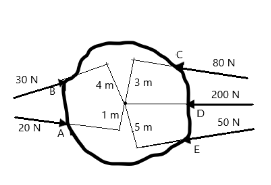
Calculate the resultant torque from the following diagram


Answer
554.4k+ views
Hint : The resultant force is the net torque produced by all the forces acting on the body. The torque in one direction should be positive and the other negative.
Formula used: In this solution we will be using the following formula;
$ \Rightarrow {\vec T_{NET}} = \sum {\vec T} $ where, $ {\vec T_{NET}} $ is the net torque acting on a body, $ \vec T $ is the individual torque acting on the body.
$ \Rightarrow T = FR $ , where $ T $ is the magnitude of the torque, $ F $ is the force acting on the body, and $ R $ is the perpendicular distance from the axis of interest.
Complete step by step answer
When there is a net torque on a body, it rotates about an axis with an angular acceleration, similarly to a net force creating a linear acceleration. Net torque can be given by
$ \Rightarrow {\vec T_{NET}} = \sum {\vec T} $ where, $ {\vec T_{NET}} $ is the net torque acting on a body, $ \vec T $ is the individual torque acting on the body. Torque is a vector quantity, hence, torque in one direction must be made as positive and the other as negative.
Torque is given as
$ \Rightarrow T = FR $ , where $ T $ is the magnitude of the torque, $ F $ is the force acting on the body, and $ R $ is the perpendicular distance from the axis of interest.
Now, making clockwise moment positive and anticlockwise moment negative, we have the torque about O to be
$ \Rightarrow \vec T = (30 \times 4) - \left( {20 \times 1} \right) - \left( {80 \times 3} \right) + (200 \times 0) + \left( {50 \times 5} \right) $
By computation,
$ \Rightarrow \vec T = 120 - 20 - 240 + 0 + 250 $
$ \Rightarrow \vec T = 110Nm $ .
Hence, the net torque is 110 Nm in the clockwise direction.
Note
For clarity, distances were used directly because, as observed, the distance given already represents the perpendicular distance from the centre of rotation.
Also, we should observe that the 200 N, although a large force in itself, contributes nothing to the torque since its line of action passes through the centre axis. This attribute of torque is why many rotating equipment tend to have long handles, so forces applied to them may generate a large torque.
Formula used: In this solution we will be using the following formula;
$ \Rightarrow {\vec T_{NET}} = \sum {\vec T} $ where, $ {\vec T_{NET}} $ is the net torque acting on a body, $ \vec T $ is the individual torque acting on the body.
$ \Rightarrow T = FR $ , where $ T $ is the magnitude of the torque, $ F $ is the force acting on the body, and $ R $ is the perpendicular distance from the axis of interest.
Complete step by step answer
When there is a net torque on a body, it rotates about an axis with an angular acceleration, similarly to a net force creating a linear acceleration. Net torque can be given by
$ \Rightarrow {\vec T_{NET}} = \sum {\vec T} $ where, $ {\vec T_{NET}} $ is the net torque acting on a body, $ \vec T $ is the individual torque acting on the body. Torque is a vector quantity, hence, torque in one direction must be made as positive and the other as negative.
Torque is given as
$ \Rightarrow T = FR $ , where $ T $ is the magnitude of the torque, $ F $ is the force acting on the body, and $ R $ is the perpendicular distance from the axis of interest.
Now, making clockwise moment positive and anticlockwise moment negative, we have the torque about O to be
$ \Rightarrow \vec T = (30 \times 4) - \left( {20 \times 1} \right) - \left( {80 \times 3} \right) + (200 \times 0) + \left( {50 \times 5} \right) $
By computation,
$ \Rightarrow \vec T = 120 - 20 - 240 + 0 + 250 $
$ \Rightarrow \vec T = 110Nm $ .
Hence, the net torque is 110 Nm in the clockwise direction.
Note
For clarity, distances were used directly because, as observed, the distance given already represents the perpendicular distance from the centre of rotation.
Also, we should observe that the 200 N, although a large force in itself, contributes nothing to the torque since its line of action passes through the centre axis. This attribute of torque is why many rotating equipment tend to have long handles, so forces applied to them may generate a large torque.
Recently Updated Pages
Why are manures considered better than fertilizers class 11 biology CBSE

Find the coordinates of the midpoint of the line segment class 11 maths CBSE

Distinguish between static friction limiting friction class 11 physics CBSE

The Chairman of the constituent Assembly was A Jawaharlal class 11 social science CBSE

The first National Commission on Labour NCL submitted class 11 social science CBSE

Number of all subshell of n + l 7 is A 4 B 5 C 6 D class 11 chemistry CBSE

Trending doubts
What is meant by exothermic and endothermic reactions class 11 chemistry CBSE

10 examples of friction in our daily life

One Metric ton is equal to kg A 10000 B 1000 C 100 class 11 physics CBSE

1 Quintal is equal to a 110 kg b 10 kg c 100kg d 1000 class 11 physics CBSE

Difference Between Prokaryotic Cells and Eukaryotic Cells

What are Quantum numbers Explain the quantum number class 11 chemistry CBSE




